| Summer
2002
Expedition to the Flannans
And for those of you who may
not have had the opportunity to see the web-pages leading up to the
expedition, click here to see the archived
information.
THE FLANNAN ISLES
STORY
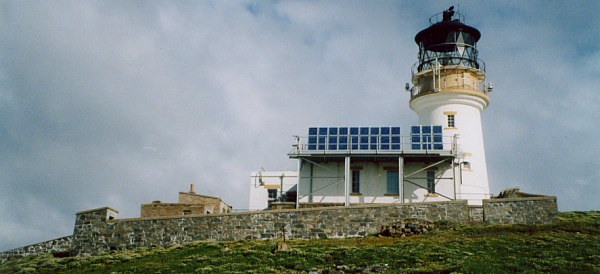
Many will recall my August 1999
expedition to the Flannan Isles EU-118 (SCOTIA DI25), accompanied by
Keith (MM0BPP). On that occasion, we sailed overnight from
Breascleit on the west coast of the island of Lewis in the Outer
Hebrides, on the fishing boat 'Coastal Surveyor', skippered
by 'Johnnie Ronnie' MacLeod.
| This was
our first experience of the infamous Atlantic swell that, even
under calm conditions, is ever-present - surging several
meters up the near-vertical cliffs of Eilean Mòr. This is the
largest of the remote Flannan group (also known as the Seven
Hunters) and is dominated by its famous, some would say
infamous, lighthouse that stands 100 metres (almost 300 feet)
above the sea.
The Flannan Light |
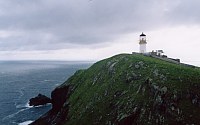
|
One December night in 1900, the year
after the lighthouse was built, it was noticed the light was out. A
landing party was sent to investigate, only to discover that all
three keepers had vanished, apparently on the 15th of December (when
the last notes had been made on the lighthouse 'slate', prior to
being entered in the official log). A half-finished meal lay on the
table, two sets of oilskin clothes were missing and a chair lay
over-turned as though knocked over by someone in a rush to get
outside.
Many theories for the multiple
disappearance have been put forward, ranging from sea monsters to
aliens from outer space. A fellow island activator and hunter Donald
(GM0KCY), now retired and one of Scotland's last lighthouse keepers,
was himself a former keeper of the Flannan light. He has told me
that, in the severe weather conditions prevailing at that time of
year, waves up to 30 metres or more (100 feet) would not be
uncommon. It would not be impossible for such enormous waves to
surge up or over the rock.
The 'official' explanation of the
disappearance is based on this possibility, namely that during a
severe storm, two of the keepers perhaps went down to check
equipment or whatever, perhaps one was struck by one of these huge
waves, perhaps the other went to seek the help of the third man and
perhaps in a rescue attempt they too were swept away.
| The poem by W.W. Gibson, "Flannan Isle",
describes the impressions of those who were sent to
investigate some days later. It ends :- |
|
|
We seem'd to stand
for an endless while,
Though still no word was
said.
Three men alive on Flannan Isle
Who thought on
three men dead.
|
|
|
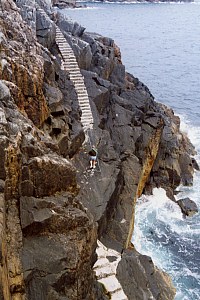
|
Such
events were hard to imagine almost a century later when, on a
relatively calm, summer morning in 1999, Keith and I landed on
what is referred to as the west landing - on some
semi-submerged steps leading onto a small concrete platform,
constantly washed by the swell and which, in a moment of
inattention, swept away a 5-litre fuel container (representing
our emergency allocation).
We soon discovered that a few shreds of
rusty bolts on the smooth cliff face, sloping briefly at 45°
before plunging vertically into the whirlpools below, were all
that remained of a 10-metre stretch of concrete steps
previously anchored to them. As I found out later, even the
lightest rain shower, or sea spray, or water dripping from
above would render the surface like glass, and would have made
that gap absolutely impossible to cross.
GM3VLB negotiates the steps up from the West
landing back in 1999. |
| However we had somehow edged across it and
painstakingly lugged our equipment up and along some
vertigo-inducing narrow ledges, to a second concrete platform.
This was some 4 metres square and was perched some 20 or 30
metres above the swirling sea. The platform had been the base
for a large crane that had been used to lift provisions from
the supply vessels to the base of the miniature cable railway.
This railway was then used to haul the cargo up to the
lighthouse. The raging seas had long since made a meal of the
crane and it was hardly surprising that the flimsy safety
railings were part of history too (other than two or three
very rusty stanchions between which we stretched a "safety"
rope). This platform became our base for the 4 days we spent
on the island, perched like wingless seagulls on the edge of
the cliff. It wasn't difficult to imagine the consequences of
one false step! The dome tent had to be put up without any
pegs, its guy wires being attached to whatever items of
equipment we felt might be heavy enough.
The 1999 west landing QTH with the
MM0BPP and the tent
perched on the old crane platform at
the end of the rails |
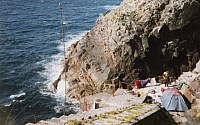 |
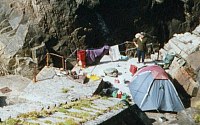 |
Landing from a two-metre fibreglass
dingy had been hazardous in the extreme; the operating position was
very precarious, and the condition of the sea so totally
unpredictable. It therefore came as no surprise when Johnny, our
skipper, informed us (via our handheld marine radio - an absolutely
essential item for trips like these) that the wind had veered to the
west, and to such an extent as to make any transfer from the rock's
west landing to the 'Coastal Surveyor' quite
impossible.
In practice, this meant that on our
last day, we had to make several exhausting trips up and over the
island to the so-called east landing, a long process threatened with
the ever-present possibility that the wind would veer back again!
When at last we had we were homeward bound, we vowed never to
return. Those who have had the opportunity to see our photographs
and the video footage have all agreed with those sentiments - and
the video camera's death-plunge into the sea on our last
shuttle-trip down to the east landing reminded us how easily we
might have followed it.
I would like to pause here to
re-iterate my remarks about marine-band capability. The absolute
necessity of this was hammered home when one of my fellow Scottish
island activators suffered a heart attack whilst on an expedition to
the Treshnish islands. The expedition team had marine-band
capability and were able to contact the coastguard and to receive
emergency medical advice from an on-board paramedic during the
relatively long wait for the rescue helicopter. As it happened, I
picked up the expedition's call for help on the 40m band, but
remember, there is a period at the beginning and at the end of an
expedition when there is no HF capability - and this
is precisely the time a slip can mean broken bones or worse, or when
the effort needed to carry heavy equipment up, down or even simply
across rocky landings can have disastrous consequences on even the
fittest activator.
On Scotland's west coast, there is no
guarantee whatsoever that mobile phone coverage will exist.
Sometimes, when there seemed to be no coverage, climbing to the top
of a hill has worked, but this can be unpleasant and dangerous in a
howling gale, or indeed impossible if incapacitated for whatever
reason.
Immediately after the incident
described above, I needed to replace a very aged Icom IC2E, and
decided to purchase the very reasonably priced HORA C150 handheld,
which has full transceive capability in the 2m amateur and 167 MHz
marine bands. I also had a word with a representative of the Radio
Agency who intimated that a 'blind eye would be turned' if marine
band use was limited to safety purposes. Since then, I have checked
in with the Coastguard as a matter of routine, whenever it seems
appropriate, giving details of my operation and letting them know
when I've safely left the island. I even did this recently, for what
may seem a simple trip to the Isles of Fleet (CS10).
On the more remote islands, a
marine-band radio may be the only way of communicating with the
fisherman or boatman (who often may also wish to communicate with
you). Surprisingly perhaps, although there is a telephone on St
Kilda (DI23), there are no telephones on The Monachs (DI22), the
Treshnish Isles (DI09), the Shiants (DI24), the Flannans (DI25), the
islands lying south of the Outer Hebrides or indeed many other
islands.
There are 11 GM IOTA islands (or
island groups), and I have now managed to activate all of them.
EU-008, 009, 010, 012, 092 and 123 are all easy. EU-059, 108,
111 and 112, though all relatively easy to land on, are much less
accessible and certainly more costly, except for very short "pop on,
pop off" operations where the boatman stands by for an hour or two
(thus making only one return trip). Such short operations to
relatively rare IOTA groups, leave many 'hunters' frustrated and
should in my opinion be avoided, if at all possible. On multi-island
expeditions, and even with careful planning with inter-island ferry
timetables, it is not always possible or convenient to overnight on
every island. Furthermore, operations involving overnight stays
(especially on uninhabited islands) are in an entirely different
league, as you need to be equipped (in terms of shelter, water, food
and fuel) not just for one night but perhaps for several, in the
event of bad weather. Incidentally, it is perhaps surprising, yet
critically important, to note how few islands have fresh water
available.
And finally - there is EU-118, the
Flannan Isles group, entirely in a league of their own.
| Perhaps
the passage of time plays tricks with one's memory. Almost
three years had elapsed since that first memorable visit with
Keith MM0BPP. Many had 'missed it' and many more had since
then joined the ranks of IOTA chasers. I was constantly being
asked if I had any plans to return to EU-118. At first my
reply was "not under any circumstances", before gradually
mellowing to "definitely not", then to "no plans", "no
immediate plans" and more recently to "you never know"!
The west landing (lower right) in
calm seas during the 1999 expedition |
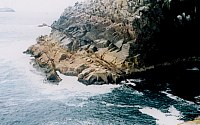 |
I knew instinctively that I would
never again attempt a 'west' landing. If there was to
be another attempt, it had either to be (1) by helicopter or (2) by
boat at the 'east' landing (and then only in near-perfect weather
conditions). I had previously looked into option (1) and indeed did
so again. Just below the lighthouse, there is a purpose built
heli-pad used by maintenance crews from the Northern Lighthouse
Board. Apart from the fact that the cost of chartering a helicopter
is absolutely prohibitive, there are also Dangerous Goods
regulations that make it virtually impossible to transport fuel and
batteries by air. (By the way, this is also true on non-vehicular
island ferries operating between certain Scottish islands, e.g. to
the Small Isles of Muck, Rum, Eigg and Canna, where special permits
must be obtained prior to such transport). Any thoughts of 'begging
a lift' on a 'pseudo-training' exercise with the Search and Rescue
helicopter based at Stornoway in the Outer Hebrides, can also be
dismissed. They had had their 'fingers burnt' after helping an
earlier DX-pedition and were under strict orders not to repeat the
exercise.
It therefore had to be solution (2),
if at all. Knowing that Jim (GM4CHX) also needed the Island of
Scotland Award Outlier Group for his 'Activator' totals, I had
invited him to join me on a possible attempt. However, he did not
take up the offer. By this time, Alex (GM0DHZ) had also become a
seasoned island activator (with 45 islands activated to date) and so
he didn't need much coercion, even though he had seen the video of
the first expedition!!
For transport, the 'Coastal
Surveyor' was available, but try as he might, Johnny could not
find a suitable boat to transfer our equipment and ourselves from
the fishing boat. By necessity, irrespective of which landing is
used, this has to be anchored some 200m offshore. Neither he, nor I,
nor his crew, would ever consider as a candidate, the 2-metre
fibreglass dinghy originally used on our previous expedition. On
that occasion, it had twice sunk to the gunwales, both times with
Keith (MM0BPP) aboard!
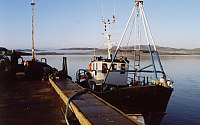 |
As
the 'Coastal Surveyor' would be carrying out it's
normal fishing duties whilst we were on the rock, the boat
would have to be lifted out of the water for the duration.
There was no way it could be towed about, in the Atlantic
swell, 'behind' a working fishing boat and there was certainly
no room 'on deck'. The only other (remotely likely) candidate
would be a small 'R.I.B.' (rigid inflatable) and even then, I
had grave doubts about whether that could be hoisted out of
the sea, vertically, up by 4 metres or more depending on the
state of the tide and the severity of the
swell. |
Johnny and I reluctantly had to admit
that, with the short time by then available, another solution was
required. Alex and I were sorry not to renew our acquaintance with
the ship and its crew, which had also taken us, in July 2000, on the
long haul to St Kilda (EU-059) and back, accompanied then by my son
Niall just returned, as VP8NJS, from Antarctica and another
'weel-kent' YL activator, Lorraine (MM0BCR).
|
There are private charter
companies (as used, for example, by the Cambridge University
expedition (GB0FLA) in 1989). Such a charter would cost in the
region of $5000 nowadays. Alternatively, we could go as
individual private passengers (perhaps for $700 a head) on
such a chartered vessel but it would then be up to the skipper
to decide which islands (if any - depending on the weather!)
would be visited, or indeed whether any landing might be
possible once the boat arrived at that
island. |
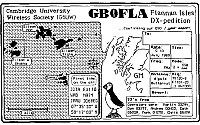 |
In 1999, I had spoken about my
original Flannan plans to Murray Macleod, who runs "SEATREK", a
small commercial operation that takes fare-paying passengers on
sightseeing tours to wherever the weather allows. By 'sightseeing',
I mean whale and dolphin watching, although he also runs visits to
St. Kilda, the Flannans, The Monachs and elsewhere. I already knew
of his reputation as a first class skipper, something that is
essential to survive in those seas.
While we were on St. Kilda, that
intrepid activator Bill (G(M)4WSB) had made a lightning trip to the
Flannans himself, and with Murray's 'Seatrek' outfit.
However, it was a very short-lived operation due to a rapid
deterioration of the weather (the full force of which we ourselves
later experienced as we were leaving St Kilda). Anyone tempted to
say 'but August is summer-time' had better think again - the gales
are perhaps less severe and less prolonged than in the winter
months, but don't ever underestimate their ferocity!
I knew Murray relied on large RIBs
(over 8 metres long), and although I have ventured out in many
similar (but much smaller) RIBs on my island travels, the thought of
a 30 or 40 mile crossing, in rough seas, was a bit daunting. Despite
Bill's reassurance, hanging onto safety ropes around the perimeter
of a small RIB, with 2 or 3 metre waves crashing over you can be a
frightening, if not backbreaking experience, as Alex will readily
testify. And that was in the relatively sheltered Ulva Sound, not
more than a couple of hundred meters offshore.
As I had explained to Alex prior to
our departure, 'you pay for what you get'! Our estimate for the cost
of getting from the Hebrides to the Flannans with 'Seatrek'
would be considerably higher than we had originally allowed for, but
there was clearly no alternative. It was already the end of July,
and Murray had told me that the weather had only allowed him to
visit the Flannans twice since April, but that it looked as though
there was a possible window in the weather the first week in August.
I took the decision, chartered 'Seatrek', and summoned Alex
up from Portsmouth in the deep south of G-land.
A few days later, and a six-hour drive
from the Scottish Borders, we found ourselves at the northern tip of
the Isle of Skye. From there we enjoyed a pleasant, calm, 2-hour
crossing to the Outer Hebrides, followed by another 2-hour drive up
through the Isles of Harris and Lewis to the sheltered harbour of
the hamlet of Uigean on the island's remote west coast.
| There it
was - a brand new, beautiful, 8-metre ocean-going RIB, with
all the latest navigation, communications and safety equipment
necessary to operate in the wild waters of the Atlantic Ocean.
In fact, with his huge past experience in such vessels, Murray
had designed and built much of the open-type superstructure
himself. It was certainly a vessel that inspired
confidence.
Murray Macleod's brand new 8m RIB
"SEATREK"
with our small pile of expedition gear,
ready to go |
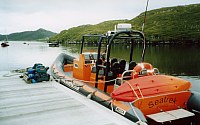 |
Alex and I were warmly received at
their home by his charming XYL, and a short time later Murray
himself arrived. We made final arrangements for departure the
following morning and were soon having a quick meal and stretching
out in our sleeping bags in our mini-mobile home for a well-deserved
sleep - it had been a long day, and the following one would be even
longer.
Thursday morning, on the 8th of
August, we rose early and had a light breakfast before driving down
to the pontoon where we unloaded everything required - ticking items
off against our checklist. We intended to be on the Flannans for 4
or 5 days but had emergency food, water and fuel to stretch the stay
to perhaps 10 days. When these ran out, a call to the Coastguard
would most likely ensure a return trip by helicopter (or at least an
air-drop of essential rations) and a certain mention in the various
media.
| Murray
soon arrived with a couple of family relief crew and in
minutes everything was loaded in the watertight forward
compartment. Several hundred horsepower of inboard engine
roared into life, we straddled our motorcycle type seats, cast
off, and gently purred our way through the channel leading
towards the open sea, passing the islands of Gt. Bernera
(HI27) and Vacsay (Burns Is. - HI26) to starboard, until
finally the radio masts perched on the cliffs of Gallan Head
slipped behind us on our left. Straight ahead, lying low on
the horizon, lay our objective - the dark outline of the
Flannan Isles. |
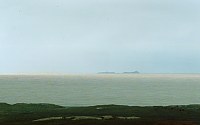 |
The radio burst into life as Murray
checked in with the Stornoway Coastguard on Channel 16, giving our
proposed itinerary and receiving the latest weather reports from
them. There was even a formal Coastguard request that Alex and I
keep in regular VHF contact with them once we were on the rock. We
then surged forward as Murray opened up to full throttle, and the
RIB rose up onto its cruising plane and settled down at something
approaching 50 mph. The earlier gentle breeze now felt much stronger
and the crests of the increasing Atlantic swell reached several
meters above the troughs.
The old story that every seventh wave
is a big one seemed to be verified. Murray never took his eye off
the sea and, every few moments, the throttles were shut back to
allow the RIB to climb carefully up and over these enormous waves.
Hitting one at full speed would surely have induced a backwards
somersault and would have spelled certain disaster. In between the
'big ones', the ride would have tested the skills of a bucking
bronco rodeo rider. I soon discovered that the jarring on the whole
human frame was slightly less if, instead of sitting, you crouched
over the seat, with your knees slightly bent to absorb the shocks
(as indeed Murray was doing at the controls).
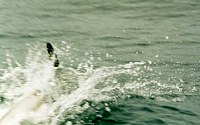 |
As we
slowly got used to the ride, we were able to concentrate on
other things such as searching the bouncing horizon for whales
or dolphins, catching sight of the Flannan lighthouse now
visible on the skyline, or in my case trying to hold the
camcorder steady - an impossible task! After a few false
alerts, when Murray had throttled back at the shout of
"Whales!", one of our keen-sighted co-riders shouted
"Dolphins!". Sure enough, as we came to rest, wallowing in the
deep swell, a huge white dolphin crossed under the RIB with
almost lightning speed, followed by another and
another.
A white dolphin surfaces beside the
"Seatrek" en route to the
Flannans |
They shot back and forth, round and
under us, occasionally leaping in perfect synchronisation on our
starboard side that, for some reason, they seemed to prefer. We
watched these gentle giants play for a long time before gradually
turning up the throttles again. Still their huge white shapes stayed
just ahead of us, demonstrating their incredible power, speed and
agility as several metres of muscle leapt out of the water. It was
as though they knew exactly where we were headed. We thought for a
while they might lead us all the way to the Flannans but we must
have reached the outer limits of their current territory, as they
were gone as suddenly as they had arrived.
| With the
huge Flannan light towering above the near vertical cliffs of
Eilean Mòr, we were soon entering the calmer waters between it
and the other 'Seven Hunters'. There was to be only one
way on to the island. As Murray slowly edged forward, and very
briefly wedged the nose of the RIB into the rocks, I gingerly
jumped onto a narrow seaweed-covered but reasonably flat rock,
at the same time reaching for a vertical stanchion which had
been better galvanised than its neighbours. As I did this, the
swell pulled the RIB down and away below me. But, it felt good
to be on the Flannans again!
The white arrow shows the east
landing as we approach |
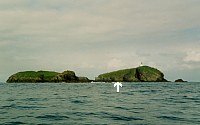 |
Alex followed on behind, as Murray
threw me a climbing rope and we hauled all the equipment vertically
up the face and onto the landing platform as he tried to keep the
big RIB on station in the swell. By the time I had finished, my
hands were raw (I tried to imagine the effort that would have been
required to haul a dinghy or smaller RIB from the water onto the
platform!). Murray then offered to anchor off and let the others
visit the island, but I think that they had seen how much equipment
we had and, suspecting they might be roped in as porters, they
declined the invitation!
| Alex
soon realised I had not been joking when I had spoken of
narrow concrete steps (with a depth of maybe only half a shoe
length and without any guard rail), which rose at an angle of
60° from a concrete landing stage - at this moment about 4
metres or more above sea level - that sported the remnants of
a vertical iron ladder that I wouldn't have hung my hat on.
These steps climbed to another platform some 20 metres above
the sea and, from then on, a path climbed a further 30 metres
at a 'much gentler' (!) 45° or so, but which was covered in
long, slippery grass, saturated by water running off the
higher ground. The path then met up with the 'present end' of
what remained of the mini-railway, levelling out to a slope of
about 30°, running in a long right-hand sweeping curve up to
the lighthouse.
Looking back down the steep steps
to the east landing, here we can see the 2m dingy
that was
used to do the shuttle transfer to and from the "Coastal
Surveyor" back in 1999 |
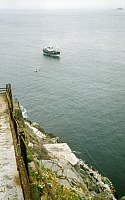 |
We began the long, multiple haul of
equipment, leaving some fuel and a car battery at the second level,
as it would not be immediately required. I had started to take my
first load up the final stretch when a massive whoosh of air
over my head made me belatedly duck. No it wasn't an RAF Tornado,
but instead was an enormous feathered bird that, though never having
seen one before, I soon identified as a skua, and more accurately
(later) as a great skua. The body length of the adult male is
typically 2 feet, with a commensurate wingspan. A great skua
attacking from behind with incredible speed and agility is not
something you ignore, and a pair of them was repeatedly attacking
me. I guessed I must be near their nesting site. They circled high
over head and each time I tried to move, they came in like fighter
bombers on the final bombing run, just skimming the ground before
climbing steeply at the last moment and missing my head by inches.
The agility of such a large bird is quite incredible. I have no
qualms about admitting that I was afraid - primarily afraid of the
possible injuries I might sustain should one of these birds'
navigation systems be slightly off-tune.
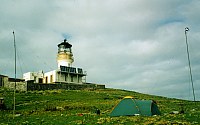 |
After
what seemed like an eternity, I had managed to edge forwards
about 50 yards and realised I was no longer a target. I was
out of their "patch". I veered off the railway track, up and
over the soggy grass, and up towards the heli-pad to select a
suitable site for the tent and the two 24-foot masts. One mast
would support the 20/40/80m multi-band dipole and the other,
the 10/12/15/17/30m version.
The QTH below the
lighthouse |
I temporarily used a brightly coloured
1-metre aluminium mast section as a 'weapon' and found this very
effective - the skua is not stupid, they were not going to be
'grounded' before me! After each attack, it took them time for them
to climb to a height high enough to launch the next dive-bombing
run, and during this time I moved forward as much as I could before
swinging round to 'repel' the next attack. It almost became a game,
a deadly one, I thought. Whether they tired, or whether they
realised I was just 'passing through' and not really a threat after
all, I cannot say, but the attacks gradually subsided and Alex
subsequently had a relatively free passage.
| Up at
the camp-site, we had no 'skua' trouble at all - throughout
our stay, and I can only suggest that the enthusiastic Sunday
Mail reporter whose article said "Two radio hams were
forced to flee a cursed Scots (sic) island after being
attacked by giant Arctic skuas" certainly had a vivid
imagination Maybe he was reliving the scenes in Hitchcock's
film "The Birds"!
A typical 'vivid' article from the
UK tabloid press |
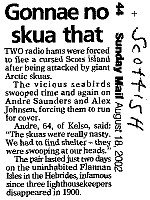 |
The facts of the matter were that
Stornoway Coastguard had put out a severe gale warning for Monday
the 12th of August. We could not have expected to be taken off the
rock on the Sunday, for no other reason than the long-standing local
islander's tradition of holding Sundays as their 'days of rest'. We
could have decided to ride out the storm, after all we had adequate
provisions for a few days and emergency shelter was possible in one
of the lighthouse outbuildings. However, storms in that area ARE
unpredictable, and even if it had abated, and Murray had managed to
make the trip, the big problem would still remain - the transfer
from the rock back into the RIB with all the equipment. The
Coastguard would most likely have helped in such an emergency, but
it was obvious that they would have taken a dim view if they had had
to take us off by helicopter AFTER we had ignored their weather
warning. My eventual decision to terminate the operation on the
Saturday was therefore quite an easy one.
Far from being "forced to
flee", I decided, on our second day, to venture closer to skua
territory, hopefully to induce a dive-bombing attack and capture it
on the camcorder. However, I had great trouble arousing any
interest, although one brave bird did mount a completely unexpected,
very high speed, ground level, frontal attack which took me totally
by surprise and resulted in me almost falling over backwards and
which ended up with me getting rather a poor video shot!
Radio-wise, the operation, though
curtailed, was reasonably successful. As in 1999, conditions were
poor, despite us having an apparently better site this time, being
up near the top of the rock rather than perched halfway up a cliff
face as Keith and I had been. It was primarily short skip conditions
into Europe, with virtually no early morning propagation to
W6/W7/KL7 or to VK/ZL and with only one or two JAs making it into
the log. However, despite being on the air for almost one day less
this time, my QSO total was 20% more, our overall total being around
1500. This year, we had made a conscious decision to operate not
only on more bands - indeed, I had built a second mast and another
multi-band inverted 'V' for 10, 12, 15, 17 and 30m - but also on
CW.
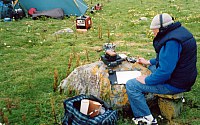 |
Alex
GM0DHZ found a large rock near the tent, on which he balanced
his TS-50S and his electronic keyer, with another couple of
rocks stacked to support his rear end! |
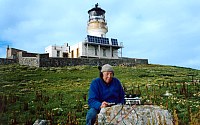 |
It was nice to hear many of our SSB
'regulars' also calling us on CW. And no, the GM3VLB/p you have been
hearing recently on CW was not a pirate! Thanks to many torture
sessions organised by well-known Dxer Steve Gibbs (GU3MBS/VQ8CC
etc.etc.) back in 5Z4-land in the 60s, I am still occasionally
capable of a respectable performance on the key!
| We had
pitched our tent on the only bit of flat ground available,
immediately next to the heli-pad. It would have been
interesting to see if it would have survived the down-draught
of a helicopter landing! Certainly, we would have had to lower
our HF multi-band dipole had we had such a visitor.
The Flannan Lighthouse
helipad,
with the QTH in the background |
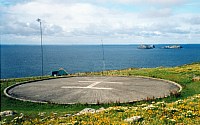 |
During one of our few breaks, other
than those for hurried meals, we were able to explore a bit. Extreme
care must be taken on the rock - any slip could prove fatal. One
strange fact is that although we were visiting at the same time of
year, we did not see any sign of the hundreds of black rabbits I had
seen with Keith in 1999 - not a single one - where they have gone, I
do not know.
I talked Alex into going down to the
west landing, and to the cliff-side perch where Keith and I had
'pitched' the tent in 1999. We discovered that there had apparently
been a major rock-fall, and several metres of the track just above
the tiny platform were now missing, presumed to be in the sea. In
fact, there seemed to be a more pronounced slope on the platform
itself, and I would not be at all surprised to find the whole of
this gone before too long. I suspect that water from above is
gradually eroding the underside surfaces of the concrete and the
iron and steel used to reinforce and/or anchor it. I would certainly
NOT consider camping on it now!
There was an eerie silence at night -
with little wind, there was just the sound of the sea surging up and
down the cliffs The ghosts of the missing lighthouse keepers seem to
be the quiet type! The beam from the light, seen a considerable
distance out to sea, was sweeping rhythmically over our heads but,
in the clear air above, it was invisible to us. The light is powered
by a large array of solar panels and we noticed that the huge
mirrors rotate not only at night, but throughout the day as well
(when the light itself is of course extinguished). Presumably, once
moving in their bed of mercury, it takes less energy to keep them
moving than it would to start and stop them each day. The lighthouse
is well maintained, by the Northern Lighthouse Board. On my first
visit, the maintenance crews had just finished their stint on the
rock, and it was disappointing to see so much discarded rubbish
lying around in corners that were sheltered from the near
ever-present wind. What kind of people would leave empty beer cans,
cigarette packets, broken bottles etc., lying in such quantities in
such a remote and otherwise unspoilt environment. I had reported
this on my return and it was therefore a pleasure to see that a
cleaning party had largely removed this human detritus. (Sadly, I
see more and more of this sort of pollution on my island travels.
Some of course is washed up on shores, sometimes well above the high
tide mark by high seas, but too often, it is the result of
inconsiderate visitors who presumably behave as they would on their
home patch).
All too soon (and only because of the
severe weather warning), it was time to dismantle and make the
multi-trip journey down to the east landing to wait for Murray. It
seemed incongruous that we should be doing this in near perfect
conditions (but three days later we were forcibly reminded that
Hebridean weather can be very fickle, especially around these more
remote and exposed islands. Direct radio contact with Murray and
'Seatrek' had not been possible whilst we were on the rock,
as its homeport of Uigean lies sheltered below some west facing high
ground. Fellow activator Peter GM3OFT had been our principal
mainland 'back-up' and he was in touch with my XYL Veronica (who
relayed news on to Alex's XYL, Susan) Also keeping in touch with
Murray was my son Niall, in Aberdeen, who had found that he and
Murray shared a common passion for (ancient?) Landrovers!
We had also maintained regular
contact, via the marine band, with Johnny on the 'Coastal
Surveyor' - never far from the Flannans, as he took advantage of
the better weather to pick up a few crabs and lobster from the rich
waters around the islands. We had also monitored Stornoway
Coastguard's regular weather bulletins for our area and had
reassured them directly, from time to time, that all was
well.
As we brought down the last of the
gear, I called "Seatrek" and Murray's reply was soon followed
by Alex's superior eyesight detecting a fast-moving speck on the
horizon. The RIB was soon alongside. It was a really fine afternoon,
and some of the family had come along for the trip. While two
climbed up to the lighthouse, some of the younger generation did a
spot of fishing as everything was reloaded and stowed safely
away.
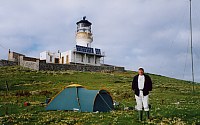 |
Eventually, passengers and equipment were back on
board and the Flannans were soon becoming a diminishing speck
on the horizon. As I looked back, I wondered when they might
next be activated. Just as mountaineers answer "because
they're there" when asked why they risk life and limb
in dangerous climbing exploits, so it will always be with
islands, whether they are on the IOTA list, or the SCOTIA or
whatever.
GM3VLB on his second expedition to
the
Flannans - will there be a third
visit? |
There are certainly far more difficult
and dangerous islands to land on and activate than Eilean Mòr in the
Flannans. I believe for example, that as long as the island of
Rockall remains on ANY island list, someone will, sooner
rather than later, attempt an operation. I only hope they live to
tell the tale. I believe that former SAS man Tom Maclean did land
(in the 1980s?) and did make some amateur radio QSOs but as he did
not have a proper licence, they were invalid. I had personally
researched the situation in the early 70s (with the help of Royal
Navy contacts as a helicopter landing would have, without question,
been necessary) and again in June 1997 when a former physics pupil
of mine was himself on Rockall as part of a Greenpeace protest team.
He approached the Greenpeace top brass on my behalf but the latter
were understandably reluctant to take on an extra
'liability'.
| Now, at
the end of 2002, within months of collecting the state
pension, I have given up any, even remotely held, ambition to
activate Rockall (did I hear someone say they had a
helicopter?!!). As they say, that's for the birds (and
madmen!).
The 'island' of Rockall, shown
here with
waves crashing over its summit |
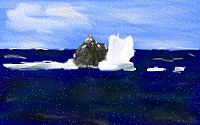 |
| That
night, Alex and I enjoyed hot showers, a good meal, pleasant
international company and a comfortable bunk in the Garenin
Scottish Youth Hostel, on the northwest coast of Lewis. We had
often stayed there before and, recognising us, the warden
welcomed us once again. We relaxed for a couple of days and
took the opportunity to visit Johnny and his good lady Annie
and her delightful mother.
The communal kitchen at the
Garenin Scottish Youth Hostel |
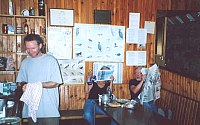 |
It was Saturday and the 'Coastal
Surveyor' had also returned to unload its catch, the Sabbath
still being a day of rest for many in those parts, and when anything
smacking of work is very much frowned upon. I had promised to try
and set up a two-way marine link between Johnny's house and the
'Coastal Surveyor'. The change from an analogue to a digital
mobile-phone system in the Outer Hebrides had meant the loss of a
vital communications link, as the range was now too great for mobile
telephone communication. Johnny normally fishes around the Flannans
and beyond, and is often away for 6 days at a stretch. It is
understandable that, with no news, one or other could become
anxious, especially in times of severe winter weather conditions. I
understand that Stornoway Coastguard is very helpful in such
situations, but relayed messages are always somewhat
limiting.
I had my MFJ-259 antenna analyser with
me, and we were able to erect and test a marine-band antenna at
their home. We also set up a power supply and checked that the
installation on the boat was in good order, despite the severe
environment it is regularly subjected to. On the Monday, the fishing
boat was once again 'working the Flannans' and we were all
delighted, especially Annie, to hear 59+ signals both ways. It is
nice to be able to help such friendly people, and to repay the
kindness and hospitality that we so often encounter in the
islands.
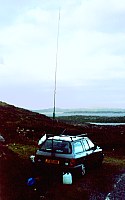 |
Later
that day, and that night, we were on Great Bernera (HI27), and
the weather began to turn nasty - as had been predicted by the
Stornoway Coastguard. The following day, Alex was able to
activate Lewis and Harris (HI21) before we set up camp on what
looked like a disused military site high up on the Island of
Scalpay (HI19), overlooking its lighthouse, and looking out
towards the Shiants Islands (DI24) where I had been a guest on
Peter (GM3OFT)'s expedition less than a year previously (again
in horrendous weather conditions!).
The mobile QTH on Gt Bernera
Scalpay lighthouse with the
Shiants in the background |
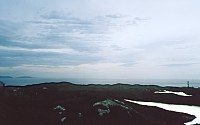 |
| The next
day, there seemed to be a lull as we sailed back to the island
of Skye (CN14). But this didn't last long. In fact, by the
time we passed through Portree, the main town, it was
deteriorating into a wild night. We had held the faint hope
that we might make the last ferry of the day from Sconser, on
Skye, crossing over to Raasay island (CN24). The ferry from
the Hebrides had been late arriving in Skye, and I was
'pressing on' trying to get there in time.
The Cuillins on Skye, seen in the
background,
from the QTH on Raasay |
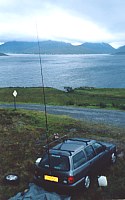 |
Although I had been having
increasingly difficulty steering the car, it was only when I nearly
didn't get round a fairly tight bend and the rear end slipped a bit
on the flooded roads, that I pulled in to a lay-by and discovered an
absolutely flat rear tyre! Of course, where was the spare?
Naturally, it was in its recess in the floor of the boot, UNDER all
the gear - and of course all I had was the original manufacturer's
jack (with its mechanical advantage geared to the needs of the
average 90-year-old lady when changing a wheel). We still beat all
records however, literally throwing everything out of, and
eventually back into, the boot, and eventually arrived at the
Sconser slipway - now firmly expecting to be camping there overnight
- only to find I had misread the time-table and we had fully 15
minutes to spare! In fact we had even more than that, as we could
now see the approaching ferry making slow headway in very heavy
seas.
The Raasay crossing is fortunately
quite a short one (which was to be even more exciting the following
morning as we returned to mainland Skye). It was a wild, wild night
but we had managed to park in what seemed like a small, almost
flooded quarry, which gave us shelter on three sides. By good
fortune, the fourth side was open with a clear take-off over the sea
crashing ashore a few hundred meters down the slope from us. The car
once again became our shack, and restaurant, and hotel, all rolled
into one. We have become quite proficient at this now and it means
we can be on the air almost immediately, using a variety of aerials,
including a full quarter-wave on 20m, whenever the car is available
to us. Indeed all our operations on this trip, other than
from the Flannans, were made using vehicle-mounted
antennae.
The following morning we watched in
amazement as the small ferry that was to take back to mainland Skye,
was wallowing in and being battered by extremely high seas. We
boarded it in trepidation, but arrived a short time later, none the
worse, on Skye. A short drive soon saw us activating Skye from the
end of the pier at Broadford, over-looking Broadford Bay ahead and
to our right, and the island of Pabay (CN17) to our left. I was
going to say we had water on three sides, but in reality it was
actually four sides, the fourth being the roof! Though the sea was
several metres below the level of the pier, huge waves were almost
totally submerging us every few moments. The car was being severely
buffeted on its right-hand side by almost continuous gusts of wind,
which must have been reaching well over 100kph.
Although fully loaded, I was still
somewhat concerned and in fact reversed the car back two or three
metres such that a large, substantial, lamp-post on our left-hand
side would hopefully act as a safety barrier should the 'big one'
hit us. It was almost hurricane conditions and we were glad when
time dictated that we should head for home, once again paying the
extortionate toll (£5.70 each way) to cross the relatively short
Skye Bridge. (I am quite sure such a level of toll in a very rural
area, with a fragile economy, would never be accepted south of the
border. As I recall, even the massive Dartford Bridge over the
Thames in London only costs £1. I would be failing the people of
that region if I didn't add my voice in protest at this
government-backed extortion - by both this and the previous
governments).
The weather improved slightly, and
some 6 hours later we were back in the Borders, 'ready for the next
one'. Since then of course, we have completed an 11-island
expedition to the Shetland, EU-012, and one to the Isles of Fleet
(CS10) but that is another story, for another time!
73 de André
(GM3VLB) |























